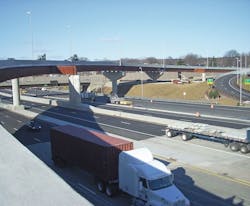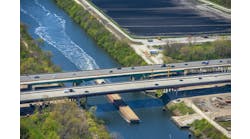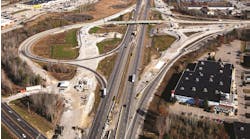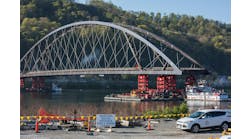PROJECT: I-78 & Garden State Parkway Interchange 142 Improvement Project
LOCATION: Union and Hillside townships, Union County and Irvington Township, Essex County, N.J.
OWNERS: New Jersey DOT and New Jersey Turnpike Authority
DESIGNER: Gannett Fleming Inc.
CONTRACTOR: Union Paving and Construction Co.
COST: $165 million
START DATE: May 2008
COMPLETION DATE: Bridge 2 (Ramp NW-D) opened to traf?c September 2009, Bridge 3 (Ramp B) opened July 2010, and Bridge 1 (Ramp SE) opened December 2010
For decades, drivers at the interchange of the Garden State Parkway and I-78 in New Jersey had to make U-turns to get from one roadway to the other because there was no connecting movement. That problem has been solved in a major construction project to join the two pieces with a variety of bridge work.
Gannett Fleming, the lead designer, had a few challenges to overcome to make the project work in a built-up section of northern New Jersey. One solution was to use steel box crossgirders built integrally with the curved steel longitudinal girders. The cross-girders were placed radial to the main girders.
“We eliminated the bad skews that would have occurred if we hadn’t been able to make radial supports with the integral cross-girders,” Rodney Miller, technical adviser for the bridge work and assistant project manager, told ROADS & BRIDGES. “That was a big factor in saving time on superstructure erection.”
Another solution was to use single-drilled shaft substructures for bridge foundations. “The drilled shafts have become popular in urban areas where footprints are an issue and you don’t have a lot of work space,” Miller said. “They’re not necessarily cheaper than a normal spread or plow foundation, but sometimes they’re the only reasonable choice.”
Conventional concrete hammerhead piers were utilized on the approaches to the skewed crossings. Several of the piers also utilized drilled shafts, which not only saved on
footprint, but also eliminated expensive and time-consuming excavation.
“We were working on a lot of side slopes, where the pier foundations were located,” Ray Stauffer, project engineer, told R&B. “A couple of the piers were in the median area of the parkway and I-78, where we didn’t really have room to open up a big excavation. The drilled shafts can be extended vertically and then become the shaft of the pier as well.”



